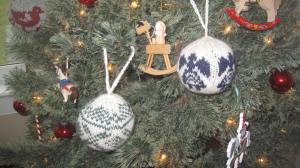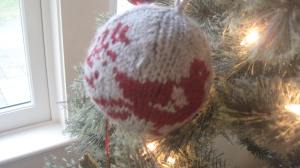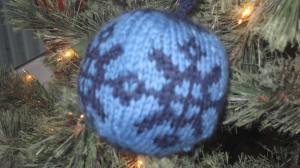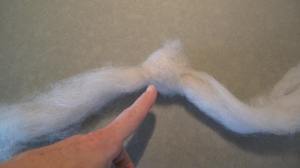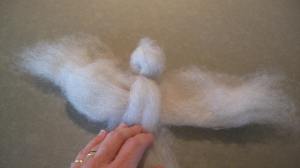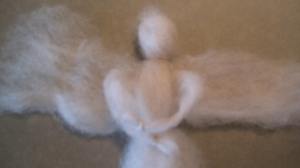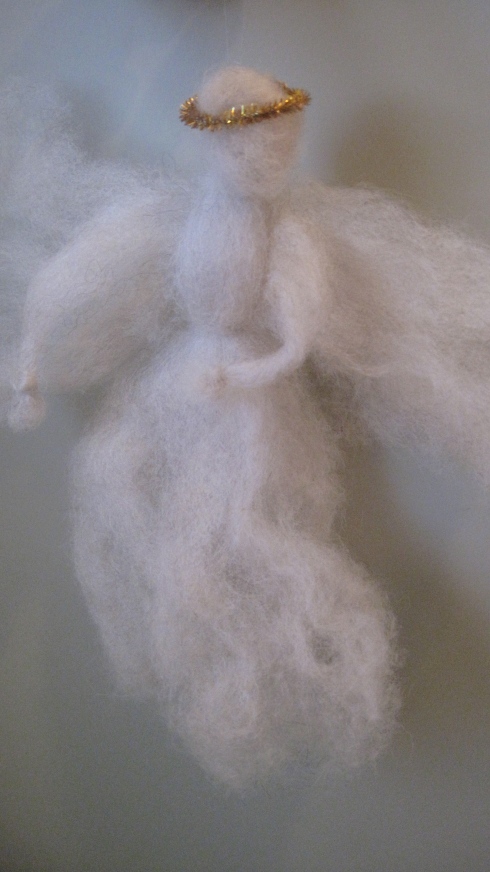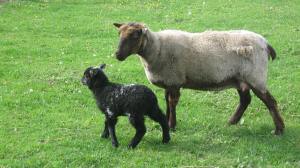The dingy, beige plastic bag in the back of the attic cedar closet sat untouched for almost 25 years, save the move from the urban apartment to the old country farmhouse. I never completely forgot it, lodged in between the piles of extra pillows and woolen blankets, and nestled with other uncompleted adventures in knitting. A complicated Norwegian sweater for my husband, forever stunted in vest form, awaits sleeves. A flowery short sleeve sweater and its German pattern have not seen the light of day since that Heidelberg research summer two decades ago. A bigger, more controversial ghost inhabited the beige bag. Inside languished the nearly complete front of a blue Icelandic sweater, the final project my mother knit during her last year. She knit like Penelope unwove, to postpone the seemingly inevitable. She knit one winter, to be warm and alive the next. And before her death in September of 1988, she asked me to finish it.
I have been knitting on and off since Mrs. Pohl’s second grade classroom. A Peggy Fleming look alike, she took us one by one, when we had finished our reading assignments, to the seat next to her desk, and taught us how to cast on, and how to knit and purl on fat, pastel blue, plastic needles. My curiosity was peaked enough to ask Mom to show me more. I never actually made anything until college, when I spent a year in Vienna, surrounded by friends who knit each afternoon while enjoying their coffee, and young women who knitted in the packed lecture halls of the university. As soon as I got back to the States a trip to a yarn shop set off a long string of projects, all of which I was able to finish in the early years of a career and then graduate school. Eventually I took up weaving and set aside the needles until my wool obsession reached its apex – I started raising sheep, learned about raw wool, and suddenly had more wool than any woman needed.
Through all of this, that bag sat in the closet, occasionally glanced at, yet never touched. If I did think of it as I purchased yarn for a new project, I told myself that Mom’s sweater would never fit me, the daughter with broader shoulders. The style was outdated. I don’t tend to wear blue. But recently, 25 years since her death, it dawned on me that I could adapt the sweater, make something out of it, improvise and honor, not forget. A pillow seemed the perfect solution. Why not just knit the front up into a rectangle and make the back the same, stuff it with some of my own sheep’s wool, and stitch it up?
I took the bag out of the closet, and set it on the floor next to my favorite chair, where it sat for a couple of weeks. I avoided the bag, as if some kind of magic might escape if opened. Next, I took out the pattern book and opened to the page marked by a special plastic ruler that slides up the chart to mark the knitter’s spot, fitting over the side of the page, like a giant paperclip. Notes stuck inside revealed my mother’s suddenly familiar handwriting, a knitter’s secret hieroglyphs, left for me to decode. These messages struck me hard. I had not seen my mother’s handwriting in years, but, like a bottle washing up on shore, this disordered shorthand on scraps of paper and on the pattern’s margins overtook me. Red ink on one scrap, blue on the next. But oddly enough, what might have puzzled someone else made perfect sense to me. I take the same kind of notes – the kind that no one else can read, let alone decipher.
I kept the book nearby a few more days and even began carrying the project with me when I knew I would have some time to fill. Still I kept it at arm’s length. One afternoon in my children’s quiet school library where I volunteer, after shelving books and offering story time to a preschool class, I took out the Icelandic knitting book and then gingerly pulled out the blue and white sweater front. I untangled the balls of Lopi yarn and found the thick wool stitches crammed on a needle. With today’s renaissance in knitting, everyone uses bamboo, wooden, or carbon needles, designed to ease stress on fingers and wrists and to keep the yarn from slipping. Mom’s were the good old metal economy model, needles, which, in contrast to the sturdy wool, brought a chill to my hands. The symmetrical snowflake emblazoned in white on navy was nearly complete, leaving me about one quarter of the front to finish. I counted the number of white stitches on the needle, and then scanned the chart, realizing that she had checked off each completed row. I had found my passageway in, the cord through the labyrinth, the way back to Mom, one more time.
I took up the full needle in my left hand, grasped the empty needle that had waited twenty-five years to work again in my right, and started across the first row. It was slow at first, the needles clunky and the stitches tight. I adjusted the yarn’s tension to free each loop. I counted stitches from the center marker and the preceding row and made sure to carry the unused white yarn loosely behind. I was so elated, or was it relieved, to finish the first row that I was halfway across the second when I realized that I should be purling instead of knitting. So I undid the stitches and soon erased the mistake. A few more free minutes and another row or two was all the time I had that day. But since then, I have finished the front and am working on the back. I stitched in mom’s initials and mine. I picked up where Mom left off, finally unafraid to complete the conversation.


